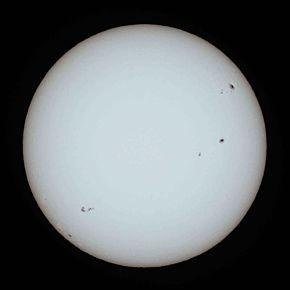The Sun History

The Sun 

Sun with sunspots and limb darkening as seen invisible light with solar filter.
Observation dataMean distance
from Earth1 au ≈ 1.496×108 km
8 min 19 s at light speedVisual brightness(V)−26.74 Absolute magnitude4.83 Spectral classificationG2V[2]MetallicityZ = 0.0122[3]Angular size31.6–32.7 minutes of arc[4]AdjectivesSolarOrbital characteristicsMean distance
from Milky Way core≈ 2.7×1017 km
27,200 light-yearsGalactic period(2.25–2.50)×108 yrVelocity≈ 220 km/s (orbit around the center of the Milky Way)
≈ 20 km/s (relative to average velocity of other stars in stellar neighborhood)
≈ 370 km/s[5] (relative to the cosmic microwave background)Physical characteristicsEquatorialradius695,700 km[6]
109 R⊕[7]Equatorialcircumference4.379×106 km[7]
109 × Earth[7]Flattening9×10−6Surface area6.09×1012 km2[7]
12,000 × Earth[7]Volume1.41×1018 km3[7]
1,300,000 × EarthMass(1.98855±0.00025)×1030 kg[1]
333,000 M⊕[1]Averagedensity1.408 g/cm3[1][7][8]
0.255 × Earth[1][7]Centerdensity(modeled)162.2 g/cm3[1]
12.4 × EarthEquatorialsurface gravity274.0 m/s2[1]
27.94 g
27,542.29 cgs
28 × Earth[7]Moment of inertia factor0.070[1] (estimate)Escape velocity
(from the surface)617.7 km/s[7]
55 × Earth[7]TemperatureCenter (modeled): 1.57×107 K[1]
Photosphere (effective): 5,772 K[1]
Corona: ≈ 5×106 KLuminosity(Lsol)3.828×1026 W[1]
≈ 3.75×1028 lm
≈ 98 lm/W efficacyMeanradiance (Isol)2.009×107 W·m−2·sr−1Age≈ 4.6 billion years[9][10]Rotation characteristicsObliquity7.25°[1]
(to the ecliptic)
67.23°
(to the galactic plane)Right ascension
of North pole[11]286.13°
19 h 4 min 30 sDeclination
of North pole+63.87°
63° 52' NorthSiderealrotation period
(at equator)25.05 d[1](at 16° latitude)25.38 d[1]
25 d 9 h 7 min 12 s[11](at poles)34.4 d[1]Rotation velocity
(at equator)7.189×103 km/h[7]Photospheric composition (by mass)Hydrogen73.46%[12]Helium24.85%Oxygen0.77%Carbon0.29%Iron0.16%Neon0.12%Nitrogen0.09%Silicon0.07%Magnesium0.05%Sulfur0.04%
The Sun is a G-type main-sequence star (G2V) based on its spectral class. As such, it is informally referred to as a yellow dwarf. It formed approximately 4.6 billion[a][9][18] years ago from the gravitational collapse of matter within a region of a large molecular cloud. Most of this matter gathered in the center, whereas the rest flattened into an orbiting disk that became the Solar System. The central mass became so hot and dense that it eventually initiated nuclear fusion in its core. It is thought that almost all stars form by this process.
The Sun is roughly middle-aged; it has not changed dramatically for more than four billion[a]years, and will remain fairly stable for more than another five billion years. After hydrogen fusion in its core has diminished to the point at which it is no longer in hydrostatic equilibrium, the core of the Sun will experience a marked increase in density and temperature while its outer layers expand to eventually become a red giant. It is calculated that the Sun will become sufficiently large to engulf the current orbits of Mercury andVenus, and render Earth uninhabitable.
The enormous effect of the Sun on Earth has been recognized since prehistoric times, and the Sun has been regarded by some cultures as a deity. The synodic rotation of Earth and its orbit around the Sun are the basis of the solar calendar, which is the predominant calendar in use today.
#https://en.m.wikipedia.org/wiki/Sun